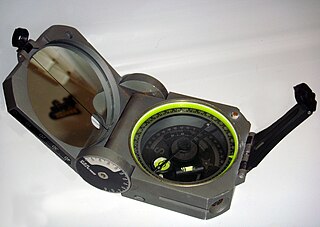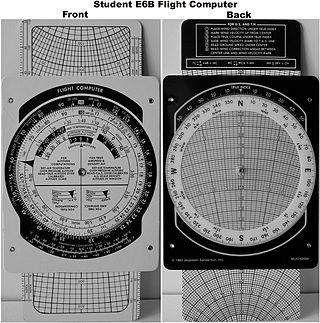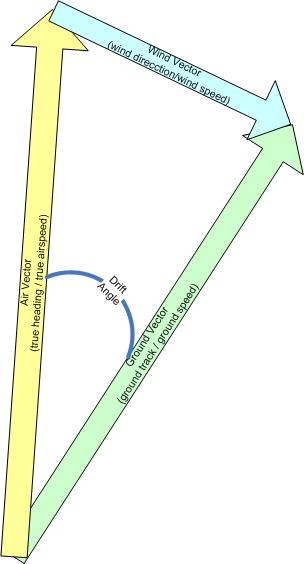
A drift meter, also drift indicator and drift sight, is an optical device used to improve dead reckoning for aircraft navigation by measuring wind effect on flight.

A drift meter, also drift indicator and drift sight, is an optical device used to improve dead reckoning for aircraft navigation by measuring wind effect on flight.
A drift meter consists of a small telescope extended vertically through the bottom of the aircraft with the eyepiece inside the fuselage at the navigator's station. A reticle, typically consisting of spaced parallel lines, is rotated until objects on the ground are seen to be moving parallel to the vertical lines. The angle of the reticle then indicates the aircraft's drift angle due to winds aloft. It is also used to calculate the ground speed by measuring the time it takes for an object on the ground to pass from the upper to the lower horizontal line of the reticle.
Drift meters were extensively used in World War II by bomber aircraft. Typically, fighter aircraft were not equipped with this kind of relatively sophisticated navigational equipment. For instance, in the Pacific Theater, where navigation was difficult due to scarcity of land or other prominent features, fighters were often guided by bombers that had a dedicated navigator and navigational equipment. [1]
Some drift meters were purely optical (e.g., USAAF Type B-5 drift meter), while others included electrically powered gyroscope (e.g., USAAF Type B-3 drift meter). [2] USAAF Type B-5 drift meter was also equipped with a simple flight computer (a rotating wheel) to calculate the ground speed from the measured time that takes for a ground object to pass from the top to the bottom of the reticle.
For practical purposes under ordinary conditions, the drift angle measured by the drift meter can be used for wind correction angle in the heading in order to put the aircraft back on the correct course, where the aircraft heading is turned into the opposite direction of the drift. [3] However, theoretically there is a difference between the two angle values depending on conditions. [4]

It is possible to derive the wind speed and the wind direction from the measurements of drift angle by the drift meter in two (or more) different headings. One method is to do it computationally by using several trigonometric functions, which is not so trivial. An alternative method is to do it graphically by using a "double-drift diagram", which is a combination of two wind triangles (see the figure). In this method, two vectors are first drawn from the center of a plane, where each vector represents one of the headings at a given airspeed (scaling factor is used, e.g., 10 cm is 100 knots). The next step is to draw a drift line from the tip of the vector into the opposite direction at an angle equal to the drift (i.e., angle with respect to the line in the opposite direction of the vector), for each heading vector. The intersection of the two (or more) drift lines then indicates the beginning of the wind vector, while the center of the plane indicates the tip of the wind vector. The length of the wind vector provides the wind speed (using the same scaling factor as for the airspeed), while its direction gives the wind direction. [5]
It is also possible to derive the wind vector by flying the heading, where the drift meter measures zero drift. This means that the aircraft is either flying directly into the wind or directly with the wind. Since the ground speed in that heading can be measured by the drift meter, one can calculate the wind speed by subtracting the airspeed from the ground speed. The sign of the difference indicates whether the wind direction is in the zero-drift heading or reciprocal to it. If the difference is zero, there is no wind present.

Flight instruments are the instruments in the cockpit of an aircraft that provide the pilot with data about the flight situation of that aircraft, such as altitude, airspeed, vertical speed, heading and much more other crucial information in flight. They improve safety by allowing the pilot to fly the aircraft in level flight, and make turns, without a reference outside the aircraft such as the horizon. Visual flight rules (VFR) require an airspeed indicator, an altimeter, and a compass or other suitable magnetic direction indicator. Instrument flight rules (IFR) additionally require a gyroscopic pitch-bank, direction and rate of turn indicator, plus a slip-skid indicator, adjustable altimeter, and a clock. Flight into instrument meteorological conditions (IMC) require radio navigation instruments for precise takeoffs and landings.

In navigation, dead reckoning is the process of calculating the current position of a moving object by using a previously determined position, or fix, and incorporating estimates of speed, heading, and elapsed time. The corresponding term in biology, to describe the processes by which animals update their estimates of position or heading, is path integration.

In navigation, bearing or azimuth is the horizontal angle between the direction of an object and north or another object. The angle value can be specified in various angular units, such as degrees, mils, or grad. More specifically:
The term “set and drift” is used to describe external forces that affect a boat and keep it from following an intended course. To understand and calculate set and drift, one needs to first understand currents. Ocean currents are the horizontal movements of water from one location to another. The movement of water is impacted by: meteorological effects, wind, temperature differences, gravity, and on occasion earthquakes. Set is referred to as the current's direction, expressed in true degrees. Drift is referred to as the current's speed, which is usually measured in knots. “Leeway” refers to the amount of sidewards translation of a vessel drifting off of or away from the intended course of travel

Apparent wind is the wind experienced by a moving object.

The basic principles of air navigation are identical to general navigation, which includes the process of planning, recording, and controlling the movement of a craft from one place to another.

The true airspeed of an aircraft is the speed of the aircraft relative to the air mass through which it is flying. The true airspeed is important information for accurate navigation of an aircraft. Traditionally it is measured using an analogue TAS indicator, but as the Global Positioning System has become available for civilian use, the importance of such air-measuring instruments has decreased. Since indicated, as opposed to true, airspeed is a better indicator of margin above the stall, true airspeed is not used for controlling the aircraft; for these purposes the indicated airspeed – IAS or KIAS – is used. However, since indicated airspeed only shows true speed through the air at standard sea level pressure and temperature, a TAS meter is necessary for navigation purposes at cruising altitude in less dense air. The IAS meter reads very nearly the TAS at lower altitude and at lower speed. On jet airliners the TAS meter is usually hidden at speeds below 200 knots (370 km/h). Neither provides for accurate speed over the ground, since surface winds or winds aloft are not taken into account.

The Norden Mk. XV, known as the Norden M series in U.S. Army service, is a bombsight that was used by the United States Army Air Forces (USAAF) and the United States Navy during World War II, and the United States Air Force in the Korean and the Vietnam Wars. It was an early tachometric design that directly measured the aircraft's ground speed and direction, which older bombsights could only estimate with lengthy manual procedures. The Norden further improved on older designs by using an analog computer that continuously recalculated the bomb's impact point based on changing flight conditions, and an autopilot that reacted quickly and accurately to changes in the wind or other effects.

A slip is an aerodynamic state where an aircraft is moving somewhat sideways as well as forward relative to the oncoming airflow or relative wind. In other words, for a conventional aircraft, the nose will be pointing in the opposite direction to the bank of the wing(s). The aircraft is not in coordinated flight and therefore is flying inefficiently.
Ground speed is the horizontal speed of an aircraft relative to the Earth’s surface. It is vital for accurate navigation that the pilot has an estimate of the ground speed that will be achieved during each leg of a flight.

The E6B flight computer is a form of circular slide rule used in aviation and one of the very few analog calculating devices in widespread use in the 21st century.

A bombsight is a device used by military aircraft to drop bombs accurately. Bombsights, a feature of combat aircraft since World War I, were first found on purpose-designed bomber aircraft and then moved to fighter-bombers and modern tactical aircraft as those aircraft took up the brunt of the bombing role.
Leeway is the amount of drift motion to leeward of an object floating in the water caused by the component of the wind vector that is perpendicular to the object’s forward motion. The National Search and Rescue Supplement to the International Aeronautical and Maritime Search and Rescue Manual defines leeway as "the movement of a search object through water caused by winds blowing against exposed surfaces". However, the resultant total motion of an object is made up of the leeway drift and the movement of the upper layer of the ocean caused by the surface currents, tidal currents and ocean currents. Objects with a greater exposure to each element will experience more leeway drift and overall movement through the water than ones with less exposure.

In air navigation, the wind triangle is a graphical representation of the relationship between aircraft motion and wind. It is used extensively in dead reckoning navigation.

In aviation, a crosswind landing is a landing maneuver in which a significant component of the prevailing wind is perpendicular to the runway center line.

The Stabilized Automatic Bomb Sight (SABS) was a Royal Air Force bombsight used in small numbers during World War II. The system worked along similar tachometric principles as the more famous Norden bombsight, but was somewhat simpler, lacking the Norden's autopilot feature.

The Mark XIV Bomb Sight was a bombsight developed by Royal Air Force (RAF) Bomber Command during the Second World War. It was also known as the Blackett sight after its primary inventor, P. M. S. Blackett. Production of a slightly modified version was also undertaken in the United States as the Sperry T-1, which was interchangeable with the UK-built version. It was the RAF's standard bombsight for the second half of the war.

The Drift Sight was a bombsight developed by Harry Wimperis in 1916 for the Royal Naval Air Service (RNAS). It used a simple mechanical device to measure the wind speed from the air, and used that measurement to calculate the wind's effects on the trajectory of the bombs. The Drift Sight eliminated the need for a stopwatch to perform this calculation, as on earlier devices, and greatly eased the bomb aimer's workload.

The Course Setting Bomb Sight (CSBS) is the canonical vector bombsight, the first practical system for properly accounting for the effects of wind when dropping bombs. It is also widely referred to as the Wimperis sight after its inventor, Harry Wimperis.
Green Satin, also known as ARI 5851, was a Doppler radar system developed by the Royal Air Force as an air navigation aid. The system provided direct measures of the drift speed and direction, and thereby allowed accurate calculation of the winds aloft. These values were then fed into the Navigation and Bombing System.